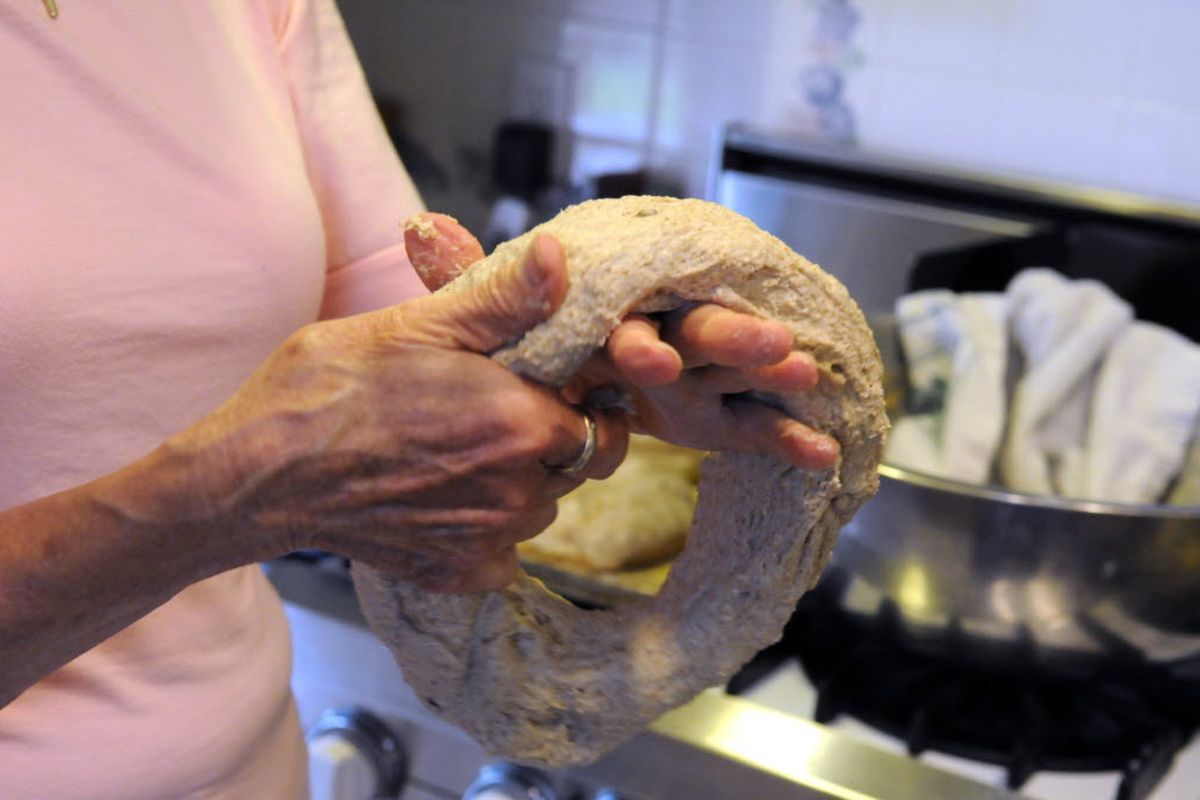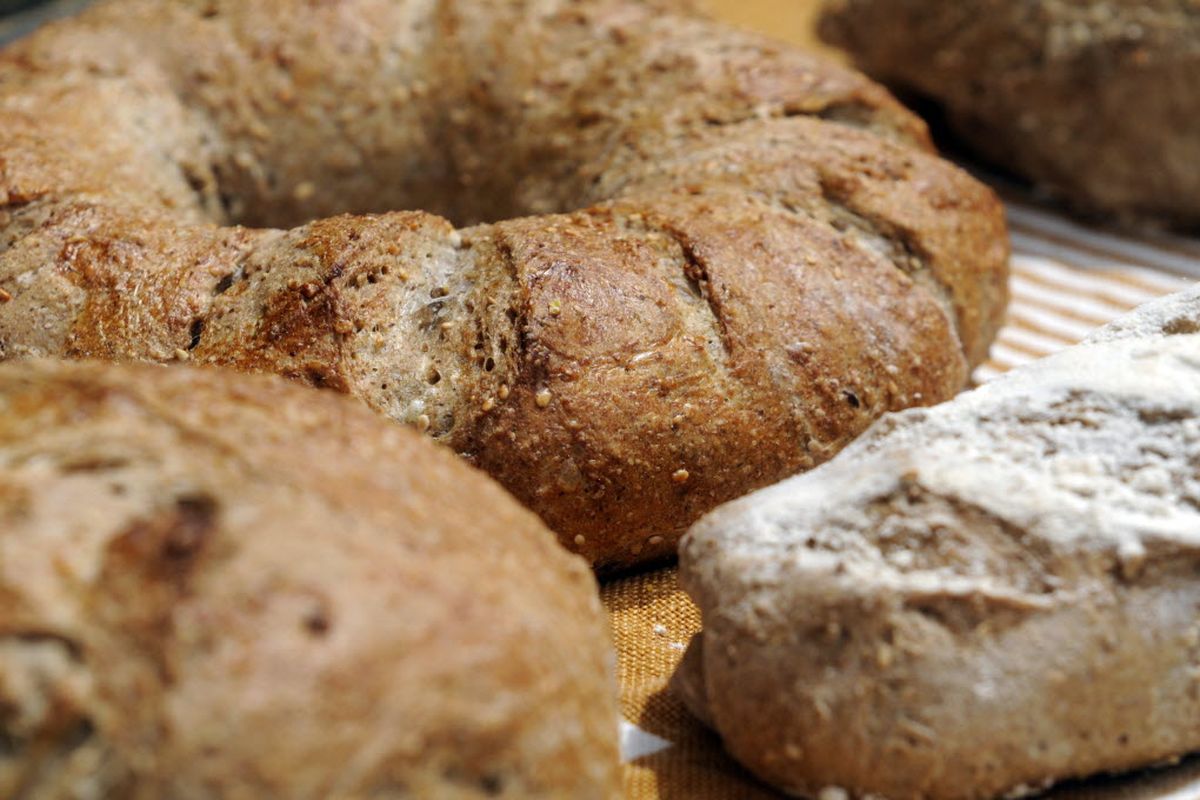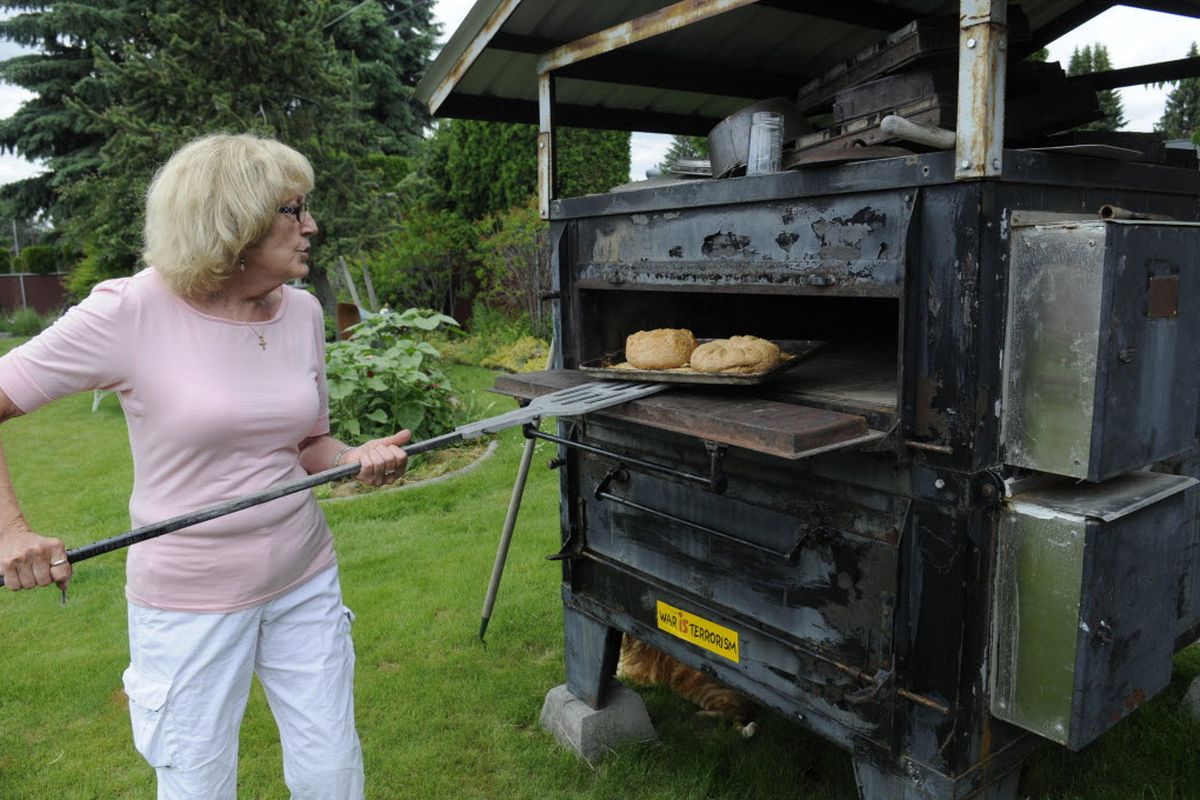Spokane baker finds spiritual side to sharing bread
Mary Lee Abba-Gaston checks bread baking in her outdoor oven. Abba-Gaston has an electric brick oven in her backyard and offers baking lessons at her home. She bought the oven from Mount St. Michael’s kitchen. (Jesse Tinsley / The Spokesman-Review)
Mary Lee Abba-Gaston grew up just down the hill from Spokane’s Mount St. Michael’s Jesuit seminary in the mid-1940s when it was buzzing with activity. Her Italian father helped care for the pigs on the 700-acre farm that provided food for the seminary.
What Abba-Gaston remembers the most from her visits to Mount St. Michael’s is taking home fresh loaves of bread from the large, brick ovens that turned out 60 loaves at a time to feed the Jesuit brothers.
Abba-Gaston’s mother baked bread every week, some of which was given away to travelers who passed by on their way to the soup kitchen at Mount St. Michael’s. “They would come and knock on the door, and my mom sent me out to give them bread. I remember that as a child,” she said. With five kids in her family, there wasn’t a lot to go around, and the philosophy of sharing bread with others made a deep impression on her.
Sharing breadWhen Abba-Gaston began baking bread for her own family, she admits that her first loaf tasted like a doorstop. She wasn’t easily discouraged. “It’s got to get better,” she kept thinking. It did, and eventually she was baking ten loaves every Friday to feed her eight children, and instructing them to share it with others.
A teacher at the time, Abba-Gaston regularly brought bread to share with her students. “They looked at me – shocked,” she said. Abba-Gaston began to realize she was doing more than instructing her students, she was connecting with them by sharing bread. “Maybe this is where my mission is,” she thought. She decided to learn more about the spiritual side of bread, and enrolled in a master’s of religious studies program at Gonzaga University.
The brick oven’s journey“I had wanted a brick oven for years, and I was lying in bed and had an ‘a-ha’ moment,” she recalled, remembering the brick ovens at Mount St. Michael’s, which closed in the 1960s. “Do you by any chance still have those ovens?” she called to inquire. In 1997, she bought the last brick oven for the scrap metal price of $250, and spent $6,000 to move the 2-ton oven down the hill and install it on her property. Shortly thereafter, she began teaching bread-making classes, fulfilling a life-long dream. “After 40-some years of baking, I never let go of that dream,” she said.
After her husband died, Abba-Gaston realized she needed to make a fresh start in a new location. She sold her farm and the house in which she raised her children, but just couldn’t leave the oven behind. In 2008 she packed up the oven and moved it across town to her new home. She unloaded it in her garage, and paid an electrical company $4,000 to wire it. When it came time for the electrical inspection, she was told she couldn’t have two meters on the same house and failed the inspection.
A distraught Abba-Gaston remembers thinking “this is a terrible mistake – I’ve already paid all of this money.” Her friends rallied around her and came with huge jacks and moved the oven out of the garage into the back yard, where it is connected to a separate meter. Perched on a cement pad and protected by a red roof, the black oven looks like a small steam engine.
Bread retreatsOnce again Abba-Gaston was ready to teach her bread-making classes. “I’m going to have to live in this house until I die, because I am not moving this oven again,” she said, laughing.
“My passion in everything I do is bread,” Abba-Gaston said. She offers bread retreats in her home, which include hands on instructions for baking and two loaves baked in the brick oven. “One is for you, and the other is to give away,” she explains. While the dough is rising, the students set the table and enjoy a meal. Basil pesto pasta with Italian sausage and celery bisque and bread are two of the most popular choices.
The lost artsIn addition to bread-making classes, Abba-Gaston teaches organic gardening. Starting with a year-long course in January, she leads students through selecting and ordering seeds; in spring she teaches garden planning and planting, and concludes with a final session on harvesting produce, including canning and cooking. She teaches courses on making sauerkraut, marinara, herbal vinegars and all of those things “people don’t do anymore,” which she calls the lost arts.
Abba-Gaston shared the following recipes and tips to try at home.
Italian PizzaThe key to a crispy crust is a hot oven. Experiment with the temperature. Some ovens might need 500 degrees.
For the dough:
1 tablespoon dry yeast
1 teaspoon sugar
1/3 cup warm water
2½ cups flour
½ teaspoon salt
1 teaspoon olive oil
For the sauce:
1 (14½ -ounce) can Italian seasoned tomatoes
1 small can tomato paste
2 cloves minced garlic
2 tablespoons Italian herbs
1 teaspoon dry fennel seeds
1 tablespoon minced onion
Toppings:
Try kalamata olives, sweet peppers, fresh basil, shrimp, sausage or artichokes.
Goat cheese, mozzarella, feta, gorgonzola or parmesan
To make the dough, dissolve the yeast and sugar in 1/3 cup warm water, letting it sit until it bubbles. In the meantime, place flour, salt and olive oil in bowl. Add the yeast mixture. Gather the dough in your hands and add tiny amounts of water at a time until the dough forms a nice, soft ball. Brush the dough lightly with olive oil and cover with a cloth and let it rise while the sauce is cooking.
For the sauce, blend all ingredients in blender until smooth. Pour into a saucepan and heat until bubbly. Let it cool.
Stretch the dough to fit greased, cornmeal covered pizza pan. Top with sauce, pizza topping and cheese. Place rack on lowest position and pre-heat oven to 475 degrees. Bake for about 12 minutes until golden brown and bubbly on top.
Yield: 1 large pizza
Kale Avocado SaladServe this salad with a loaf of fresh bread for a light, summer meal.
For the salad:
1 large bunch tender fresh kale
2 avocados cut into chunks
For the dressing:
1/3 to 1/2 cup olive oil
Juice of two small lemons
1 teaspoon freshly minced garlic
1 teaspoon red pepper flakes (or to taste)
Salt, to taste
De-rib kale and tear into small pieces, keeping only the tender leaves. Place kale and cut up avocado in large salad bowl. Whisk dressing ingredients together. Pour over kale and avocado. Mix well and let it sit to marinate for at least 2 hours before serving.
Yield: 4 servings
Cinnamon RollsUse a deep baking pan, as the whipping cream in these rolls gives them a great, airy rise.
For the dough:
1 tablespoon active dry yeast
¼ cup warm water
1 cup warm milk
2 tablespoons shortening
2 tablespoons sugar, divided
1 teaspoon salt
2 well-beaten eggs
About 3½ cups flour
For the filling:
1 stick of butter
Brown sugar, cinnamon, raisins for sprinkling
1 medium apple
½ cup ultra-pasteurized whipping cream
Dissolve yeast in warm water. Add ½ teaspoon sugar to activate yeast. Set aside. Combine warm milk, shortening, remaining sugar and salt. Cool to lukewarm. Add dissolved yeast and beaten eggs. Gradually stir in flour to make a soft dough. Knead a little and let it rise until double in size.
Put dough on a lightly floured board and roll into ¼-inch thick rectangle. Cut thin slices of butter all over the top. Sprinkle generously with brown sugar, cinnamon and raisins. Grate apple over the top. Roll up tightly. Slice in 1-inch slices and put in greased 9-by-13-inch baking pan about 1 inch apart. Let rise.
Just before placing in the oven, pour ½ cup of whipping cream all over the top of the rolls. Try not to let the cream touch the outer edges of the pan because it might scorch. Pour the cream into the cracks of each roll.
Bake at 350 degrees for 25-30 minutes until golden brown and bubbly. Carefully tip the rolls out onto a sheet of aluminum foil that has been placed on a baking rack.
Yield: About 18 rolls


